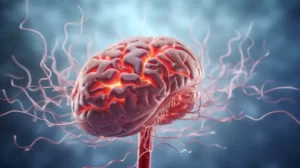A dollop of peanut butter might just hold the key to early detection of Alzheimer’s disease. Researchers at the University of Florida have discovered a unique and unexpected way to test neurocognitive health that involves a peanut butter test. It may sound unusual, but when it comes to Alzheimer’s, an individual’s sense of smell can reveal important information.
Our Sense of Smell and Alzheimer’s
It’s no secret that as we get older, our ability to identify various odors declines. However, with Alzheimer’s patients, this decline is more severe, and it affects the first cranial nerve earlier than other mental abilities. This deterioration in odor identification can be a crucial warning sign linked to brain-health issues.
The Research Behind the Peanut Butter Test
The research in Florida found a significant difference in detecting odors between the left and right nostrils in people in the first stages of Alzheimer’s. The left nostril seems to be impaired, and cannot smell the odor until it is about 10 centimeters closer to the nose than when the right nostril is used. This distinction is important since it doesn’t occur in people who experience other types of dementia. Those individuals generally have no significant difference in odor detection between nostrils or may even have weaker odor detection in their right nostril.
Why Peanut Butter?
Peanut butter is not only an accessible, inexpensive, and recognizable odor, but it’s also a “pure odorant.” This means that it’s just processed by the olfactory nerve and is not affected by other senses, such as taste. This is crucial to ensure that the peanut butter test can highlight differences between the left and right nostrils when it comes to neurocognitive health. It is important to note, though, that this test should be considered a preliminary evaluation and not a definitive diagnosis.
How Does the Test Work?
In order to perform the peanut butter test, you’ll need a partner, a ruler, and a spoonful of peanut butter. Have your partner close their eyes and hold one nostril closed. While holding the ruler to their open nostril, slowly bring the spoonful of peanut butter toward their nose. When your partner can detect the odor, measure the distance between the spoon and their nose. Repeat the process with the other nostril.
Significant differences in detection distances between the left and right nostrils can indicate early-stage Alzheimer’s. For example, if the left nostril cannot detect the odor until it’s two or more inches closer to the nose than the right nostril, it’s a potential warning sign of Alzheimer’s disease.
The Importance of Early Detection
Early diagnosis of Alzheimer’s is crucial for the best chance at managing the disease and slowing its progression. The peanut butter test may offer a valuable screening tool for medical professionals to use in conjunction with other diagnostic strategies, such as medical history evaluations, cognitive examinations, and brain imaging. This evaluation tool can enable quicker intervention, access to treatment, and participation in clinical trials. Most importantly, early detection provides time to plan care, manage symptoms, and explore support options.
Conclusion
Although the peanut butter test should not be considered a foolproof method for diagnosing Alzheimer’s, it does offer valuable insights into neurocognitive health. The test can act as a simple preliminary screening tool to identify potential issues that can then be explored further. By using a simple resource like peanut butter, individuals and medical professionals can gain the information needed to detect Alzheimer’s earlier and provide the best care and management possible.
It is important, however, to seek professional advice and further testing for accurate diagnosis and appropriate treatment. To find out more about Alzheimer’s disease, visit the Alzheimer’s Association or the National Institute on Aging.



